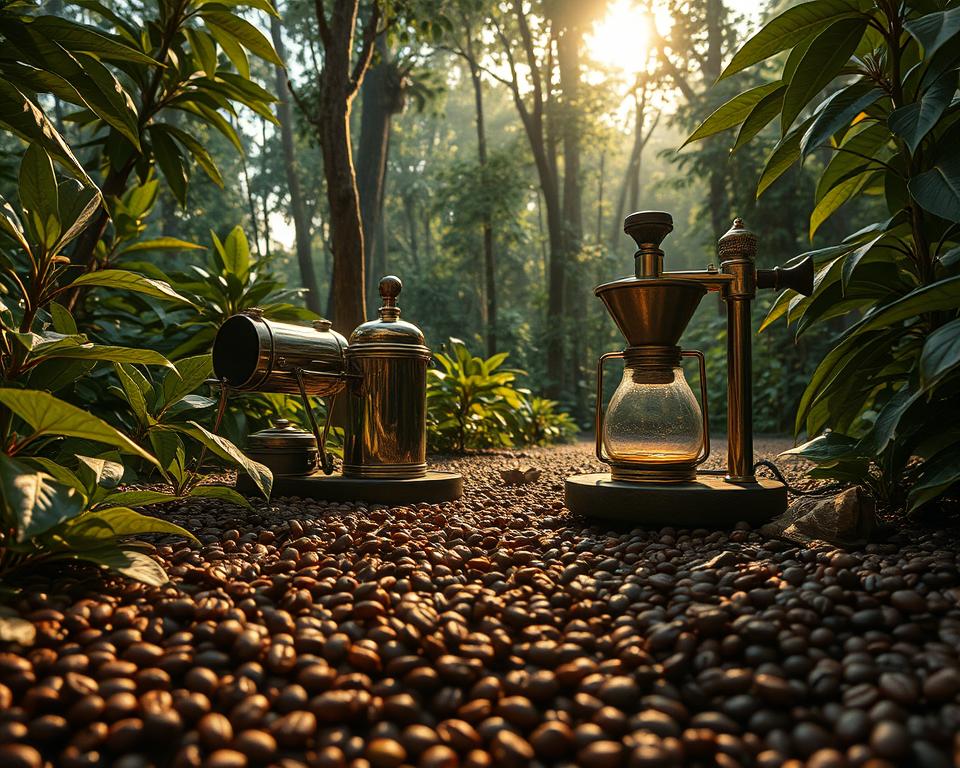Coffee lovers often think about light roast and dark roast coffee. Especially about their acidity levels. Dark roast beans are known for their lower acidity. This is due to the longer roasting time that reduces natural acids.
Light roast coffee, however, keeps most of its natural acidity. This gives it a brighter taste with hints of flowers and citrus.
USDA studies show small differences in caffeine content between roasts. Light roasts have 91 mg, mediums have 90 mg, and dark roasts 88 mg per 8-ounce cup. Even though these differences in caffeine are small, the changes in acidity are more clear.
Many people choose dark roasts to avoid stomach issues due to lower acidity. Your coffee choice should depend on what tastes good to you and how coffee affects your stomach. Understanding these details can make drinking coffee more enjoyable.
Understanding Coffee Acidity
When we talk about coffee acidity, we mean the bright tastes that make coffee special. These vibrant notes give each sip its own identity. Experts see acidity as a good thing. It makes the coffee more complex and tasty without changing its pH level much.
What is Acidity?
Acidity in coffee is the tang you feel on your tongue. It comes from various organic acids, like citric and malic acids. These acids shape the coffee’s flavor, making it range from fruity to tart. Even with these acids, coffee’s pH level shows it’s acidic, at about 4.85 to 5.10.

How Acidity Impacts Flavor
The role of acidity in flavor is huge. It can make a coffee taste from zesty citrus to berry-like. This is what makes coffee’s flavor unique. For example, malic acid adds a tartness similar to green apple. Citric acid adds a lemony zest. This diversity in flavors fascinates both professionals and enthusiasts.
Types of Acids in Coffee
It’s useful to know about the acids in coffee. Organic acids like citric and malic give coffee fruity tastes, while chlorogenic acids add a bittersweet flavor. Chlorogenic acids, abundant in coffee, are strong antioxidants. They might help reduce the risk of Type 2 diabetes and help with weight loss. When coffee is roasted, these acids break down, which can make the coffee less bitter.
Acidity adds depth to coffee, setting apart different roasts and origins. The smell and taste of coffee are linked, affected by altitude, bean type, and how it’s processed. Coffees from high places like Guatemala and Kenya are known for their bright acidity. In contrast, Brazilian and Sumatra coffees are smoother and less acidic. This variety shows how acidity is a key part of coffee’s diverse flavor world.
How Roasting Levels Affect Acidity
The coffee roasting process changes the acidity levels. From light to dark roasting, each level alters the beans chemically, affecting their acidity.

Light roast coffee is more acidic. It keeps most of the bean’s original acids. Beans are roasted to the ‘first crack’, which keeps their natural acidity. For instance, light roast beans have a pH of 4.85 to 5.10. This sharpness is what some coffee lovers like. Coffees from Guatemala, Kenya, and Costa Rica are typically light roasted to highlight their acidity.
Dark roast coffee has less acidity. It undergoes more heat and longer roasting, breaking down acids in the beans. This lowers acidity and gives a richer flavor. The process creates N-methylpyridinium, which is easier on the stomach.
To get a smoother, low acid coffee, like dark roast from Brazil or Sumatra, high temperatures for longer are key. Cold brewing these beans cuts their acidity by up to 70%. This makes the coffee gentler on your stomach.
The roasting process greatly influences coffee flavor. If you prefer light roast’s sharp acidity or dark roast’s deep notes, knowing this can help you brew the perfect cup. For more on how caffeine affects stomach acid, click here.
Light vs Dark Roast Acidity
The debate about light vs dark roast coffee focuses on their acidity, flavor, and feel. Let’s explore the acidity differences between them.
Why Dark Roasts Have Less Acidity
Dark roast coffee has lower acidity than light roast. This is because the longer roasting time breaks down acids in the beans. It also creates N-methylpyridinium, which reduces stomach acid. So, dark roast is a good choice if you want a bold but smooth cup.
Characteristics of Light Roasts
Light roast coffee is known for its high acidity and complex flavors. It’s roasted for a shorter time at lower temperatures. This keeps most of the bean’s original flavors, giving it a lively and tangy taste.
It often has notes of fruit or flowers. Light roast is great for those who love a variety of rich flavors. Plus, it’s higher in antioxidants and polyphenols, adding to its health benefits.
Comparative Analysis
Comparing light and dark roasts, we see important differences. Light roasts suit those who like a vivid flavor with more acidity. They keep the bean’s natural flavors and give a bright taste with floral and fruity hints.
If you prefer a bold, less acidic coffee, dark roast is for you. It’s better for those with sensitive stomachs due to less acid and helpful compounds. For a deeper look at whole coffee beans, see this coffee bean analysis.
Knowing these differences helps you pick the right roast for your taste and health. This makes drinking coffee more enjoyable and personalized.
Factors Influencing Coffee Acidity Beyond Roasting
Coffee bean species greatly affect coffee’s acidity. Arabica beans are more acidic with complex flavors. Robusta beans have less acid but more caffeine.
The growing altitude and conditions also play a role. Coffee from low-altitude areas is less acidic and simpler in taste. High-altitude beans, like those from Ethiopia, are more acidic with complex flavors.
Processing methods change the acidity profile. Washed methods increase acidity with a clean cup. The Giling Basah method, used in Indonesia, produces coffee with low acidity and earthy notes.
The cold brew technique is known for less acidic, smooth coffee. It extracts flavors at low temperatures over time. This might attract those who prefer a gentler taste.
Different regions influence flavor and acidity. African coffees, for example, have fruity and citrus notes. Ethiopian coffees have signature berry flavors. Sumatran coffee, on the other hand, is less acidic because of its cool growth conditions and unique processing.
Knowing these factors helps understand the variety in coffee flavors and acidity. It makes your coffee experience more enriching.
Does Specialty Light Roast Offer Lower Acidity Compared to Dark Roast?
When exploring coffee varieties, many wonder, “Does Specialty Light Roast Offer Lower Acidity Compared to Dark Roast?” Typically, light roasts showcase bright acidity, while dark roasts mellow these flavors. To find the perfect balance, many connoisseurs choose to discover the allure of light roasts, appreciating their complex profiles without overpowering acidity.
Conclusion
We all love coffee in our unique way. Some prefer the sharp taste of a light roast while others enjoy the rich smoothness of a dark roast. Knowing about coffee’s acidity can make drinking it even better.
Light roast coffees are roasted for 9-11 minutes. They have a strong acidity and a light, often floral or fruity, taste. These coffees are great for pour-over or drip brewing, which brings out their subtle flavors.
Dark roast beans, on the other hand, are roasted longer, for 12-13 minutes. They taste bolder with less acidity and bitterness. Perfect for French press or espresso, dark roasts have deep, smoky, or chocolatey flavors.
For some, choosing a coffee with less acidity is important, especially if they have a sensitive stomach. Dark roasts can be a good choice for them.
Choosing the perfect coffee roast is about what you like, how much caffeine you prefer in the morning, and how roasting changes the flavor. With a little knowledge, you can pick a coffee that tastes great and is good for your stomach. Next time, explore the range of roasts to find your perfect coffee.
FAQ
Light vs Dark Roast: Which Has Less Acidity?
Dark roast coffee has less acidity than light roast. This is because heat breaks down natural acids during roasting. This results in a smoother, less acidic flavor.
What is Acidity?
Acidity in coffee means bright, tangy, or sharp flavors. It’s what makes coffee taste vibrant without changing its pH level.
How Acidity Impacts Flavor
Acidity makes coffee’s flavor complex. It adds fruity, floral, or citrus notes. This makes the coffee lively and full of taste.
Types of Acids in Coffee
Coffee has many acids, like malic and citric. These add fruity and floral flavors. Chlorogenic acids decrease during roasting and add bittersweet tones.
How does the coffee roasting process affect acidity levels?
Roasting changes acidity levels a lot. Light roasts keep more acidity. Dark roasts, roasted longer and hotter, have less acidity and a milder taste.
Why do dark roasts have less acidity?
Dark roasts are less acidic due to long roasting times at high temperatures. This breaks down acids. It also creates N-methylpyridinium, which reduces stomach acidity.
What are the characteristics of light roasts?
Light roasts have high acidity and complex tastes. They keep more organic acids. This gives them a bright taste with floral and fruity hints.
Comparative Analysis: Dark Roast vs. Light Roast
Light roasts suit those liking bright, complex flavors with floral and fruity hints. Dark roasts are for those preferring robust, low-acid flavors. These roasts are easier on the stomach.
What factors influence coffee acidity beyond roasting?
Besides roasting, coffee acidity depends on bean type, processing, and growing altitude. Techniques like cold brew also reduce acid for a milder cup.




